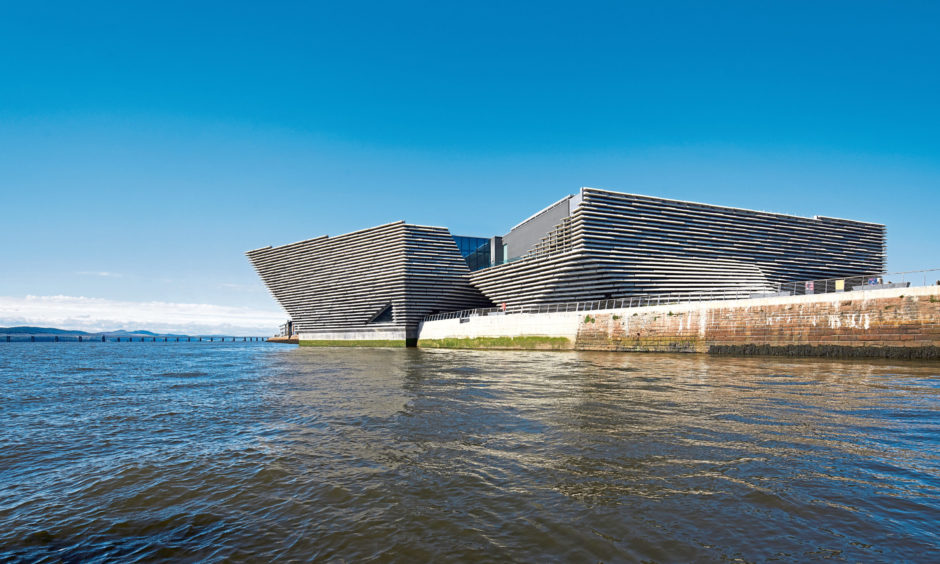V&A Dundee is five next month.
The design museum opened its doors on September 15, 2018. I can’t understand how five years has gone by since then but I’m at that age where time starts to speed up.
It may astonish you given the youthful visage that glares out at you from my byline picture – a face I’m sure you’ll agree brims with freshness and vitality – but I’ve been writing for The Courier for 21 years.
I remember the very first glimmer of an idea that a V&A offshoot might be built in Dundee and I remember dismissing the thought as ridiculous.
I remember the design contest for V&A Dundee and Kengo Kuma’s winning bid. I remember the cost rising from £45 million to £80 million.
And I remember the museum opening and none of the cost issues mattering anymore.
Because it helped change Dundee for the better. Yes it has its flaws.
There’s too much wasted space. And there aren’t nearly enough windows capturing the views over the Tay.
But it’s a world class museum forming the centrepiece of a £1 billion upgrade of the waterfront of humble little Dundee.
And it’s built to last.
Building for the future
The structure is designed to have a lifespan of at least 125 years. And the cofferdam that prevents the water from savaging the building is designed with a 200 year lifespan. Of course elements such as windows will need replaced much sooner but if it’s looked after properly our great grandchildren should be enjoying V&A Dundee exhibitions in the 2150s.
Most new buildings in Scotland are only required to have a 60 year lifespan. Buildings that are brand spanking new will only have 15 years left in them when children born today are my age.
Compare that to how the Victorians built things. Almost every street in Dundee is lined with tenement flats built between 1890 and 1910 (I know that’s slightly after Queen Victoria died but Victorian Era is a nice catch-all.)
They’re built from 600mm thick solid stone, with deep timbers holding up slate roofs. To paraphrase Shirley Jackson, they’ve stood for 120 years and might stand for 120 more.
Of course there’s a survivorship bias here. Plenty of buildings from the Victorian Era, particularly workers’ accommodation, is long gone. But the fact the overwhelming majority of flats in Dundee today are from the Victorian era shows they had the long game in mind.
Building that way is prohibitively expensive now. Never again can we develop on a mass scale in solid stone. That’s why it’s such a crime when old structures are demolished or left to rot.
Doing it wrong
This week two men were arrested under suspicion of burning down the Crooked House in Staffordshire. That such a delightful pub should burn down a week after being bought, with mounds of earth preventing fire services’ access, was a disgrace.
These things happen locally as well. In Dundee, Halley’s Mill was demolished without permission and a proposal put forward for 130 flats on the empty site.
In Gateside, a farmer who destroyed six miles of dry stane dykes avoided being ordered to replace them.
Let’s stop ripping old structures down and start building new ones to last.
Staff deserve public apology
So farewell then Grant Archibald.
This week The Courier revealed the chief executive of NHS Tayside is retiring after five years at the helm of the troubled health board.
I’ve never met the guy but I have a hard time trusting anyone who, when awarded an honorary doctorate, forevermore insists on being referred to as professor.
Real professors work for at least eight years, and often for decades, to earn the use of that title.
What concerns me much more is the fact Mr Archibald’s NHS Tayside ordered all staff to go into their workplace during the first months of the Covid pandemic.
At a time when the Scottish Government was telling anyone who could work from home to work from home, his regime wanted to see bums on office seats.
Non-clinical staff who could do their jobs just as well from home were told to get back into the workplace. In one department there wasn’t enough space for social distancing and 15 people had to share two toilets and one sink, which also had to be used for washing dishes.
My fiancée was one of the people Mr Archibald put at risk through his orders. So I was pleased to hear the whistleblowing watchdog ruled his policy was unreasonable.
I was also delighted that a now-retired manager took the bold step to go public with her story of resisting the order. She told her staff to continue working from home and said she would take the consequences.
What a brave and impressive woman.
If Mr Archibald was anywhere near as brave and impressive he would publicly apologise for his wrong-headed orders.














Conversation